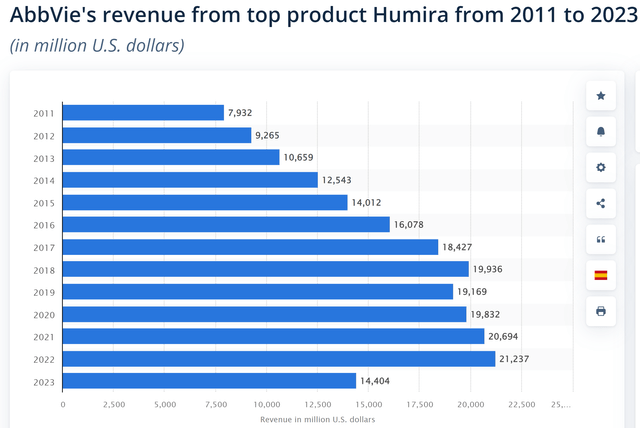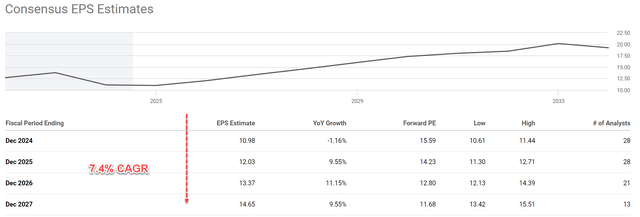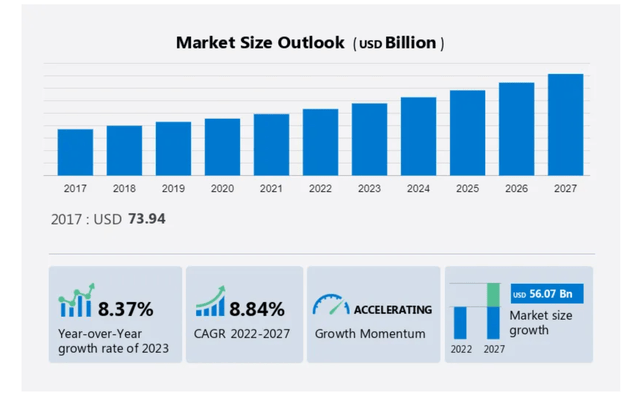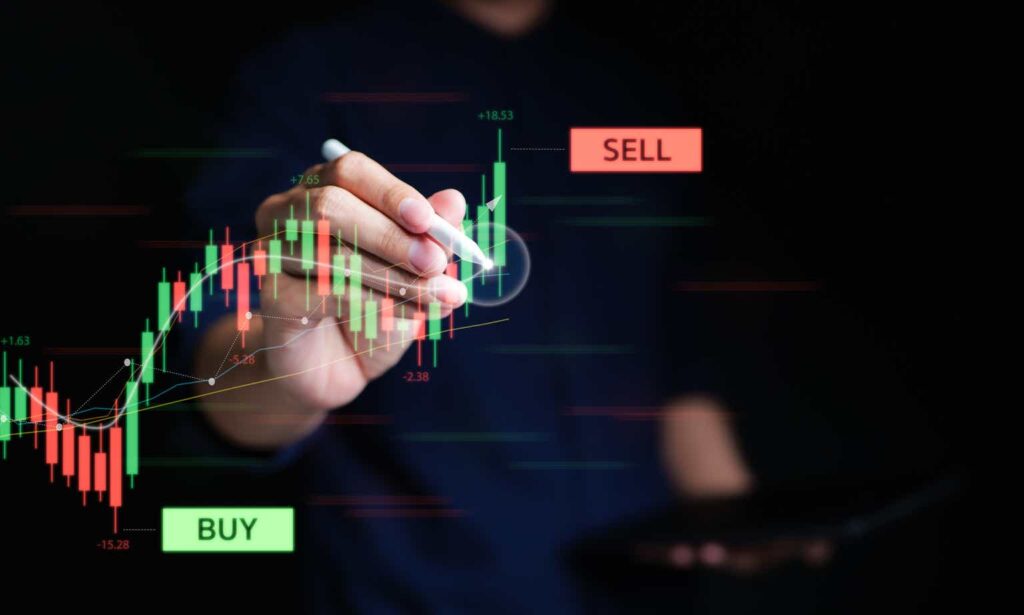I recently exited our position in AbbVie (NYSE:ABBV) from my family’s income account. As communicated in this brief post, we set a limit sell order for our ABBV shares at $175 on June 25, 2024. The order was triggered yesterday. We started accumulating our shares about three years ago and have been publishing our bullish thesis periodically since we first started writing for Seeking Alpha in 2021 (see the chart below, and you can see our first coverage on the stock here).

Seeking Alpha
The stock caught our attention thanks to its higher yield (see the chart below) and very compressed valuation due to the market concern about its patent cliff. Over the past ~3 years, we have added shares whenever the dividend yield surged over 4.5% for our income account. Thanks to the combination of high yield, valuation expansion, and EPS growth, the total return was more than 70%.

Seeking Alpha
We exited our position primarily for two considerations. First, its valuation has reached our target already. As seen in the chart above, measured by dividend yield, the stock is now trading at a premium compared to its historical average. Its current yield of 3.58% is noticeably lower than the five-year average of 4.32%. In terms of P/E, its current ratio of 15.6x is also noticeably higher than its median of 12x in the past seven years.
The second factor is that we think the market’s overaction to its Humira patent cliff has largely been normalized by now, as elaborated on next.
ABBV stock: Humira patent
A key factor in our bull thesis three years ago was the market’s overreaction to the Humira patent cliff. Our thesis at that time was that the Humira situation would not be as bad as the market feared and there the P/E compression was overdone. Indeed, the aging Humira franchise has seen sharply decreased sales in 2023 (see the next chart below) due to patent losses and the release of cheaper generics.
However, the franchise is still generating a tremendous amount of cash and remains a top-grossing drug. In the meantime, the company maintained healthy growth thanks to the new drugs, primarily its immunology drug Skyrizi (last quarter sales grew 48% year over year to $2.0 billion) and Rinvoq (grew 59% YOY to $1.1 billion).
As a result, the company has demonstrated robust top-line and bottom-line growth over the past few years, in contrast to the market’s fear. To wit, its sales growth at a CAGR of about 11% in the past five years, and cash flow by more than 14%. Its valuation expanded in tandem from an average of around 9x 3 years ago to the current 15.6x.
At this point, we think this key factor has run its course. Judging by the valuation (especially when adjusted for growth), our view is that the market has now corrected the valuation gap and is fully priced in the positives already, as detailed next.

Statistica
ABBV stock: Growth outlook and valuation
Looking ahead, the market expects healthy growth, as indicated by the following consensus EPS estimates for ABBV stock in the next few years (in contrast to the gloomy outlook it had three years ago). However, at this point, the P/E has also priced in several years of growth already, in my view. To wit, analysts expect ABBV’s EPS to decline slightly in fiscal year 2024 to $10.98. Thereafter, analysts project EPS to grow at an annual rate of around 10%. In terms of compound annual growth rate (“CAGR), the growth would be 7.4% over the next four fiscal years. As seen, ABBV’s forward P/E ratio is expected to be 15.59 in fiscal year 2024, substantially higher than its past average of around 12. Even assuming this growth projection materializes for the next four years, the implied P/E would shrink to about 11.68x, still offering little margin of safety when compared to its historical average multiples.

Seeking Alpha
The current valuation multiple does not appear attractive either when adjusted for growth. With a 15.6x P/E and 7.4% growth rate projection, the implied PEG ratio is about 2.1x, drastically above the 1x threshold that most GARP investors (growth at a reasonable price) consider as the ideal multiple. Of course, in ABBV’s case, an argument can be made that the PEG ratio underestimates its attractiveness due to its sizable dividend payouts. It’s definitely a valid argument, and I think the PEGY ratio is a more reasonable metric here because of the following considerations that Peter Lynch promoted:
For dividend stocks, Lynch uses a revised version of the PEG ratio – the PEGY ratio, which is defined as the P/E ratio divided by the sum of the earnings growth rate and dividend yield. The idea behind the PEGY is very simple and effective (most effective ideas are simple). If a stock pays out a large part of its earnings as dividends, then investors do not need a high growth rate to enjoy healthy returns. And vice versa. And similar to the PEG ratio, his preference is a PEGY ratio below 1x.
Now, for ABBV, assuming a growth rate of 7.4%, a P/E of 15.6, and a dividend yield of 3.58% translate into a PEGY ratio of 1.42, still far above the ideal 1x threshold.
Other risks and final thoughts
Besides the thin margin of safety and competition from generic drugs, there are a few additional risks worth mentioning before closing. Like other drug companies, ABBV faces industry-wide challenges, with the top one on my list being the high cost and risk of bringing new drugs to market. As an example, AbbVie recently announced that:
… it plans on reporting acquired IPR&D and milestone expenses of $937M on a pre-tax basis for Q2, which will reduce earnings per share on both a GAAP and non-GAAP basis by $0.52.
In terms of upside risks, a key differentiator stands out compared to its peers in my analysis of ABBV’s business model. ABBV boasts a strong focus on immunology, a rapidly growing therapeutic area with high unmet medical needs. This focus translates to a robust pipeline heavily weighted towards immunology treatments, including potential blockbuster drugs for conditions like rheumatoid arthritis and inflammatory bowel disease. The projected immunology market size is estimated to grow at a CAGR of 8.84% till 2027 as seen in the chart below. This growth rate for this segment thus can potentially outpace overall pharmaceutical market growth. The growth implies an addressable market size of $56.07 billion by 2027. ABBV is well positioned to capitalize on this key market segment, in my view, considering its current lineup and pipe drugs.
All told, our assessment is that in the near term (say the next 1~2 years), the stock provides an unfavorable return/risk profile, leading to our sell decision. To recap, the deciding factor in our consideration is that the market’s overreaction to its Humira patent cliff has largely been normalized by now. This normalization has resulted in a very thin margin of safety (if at all) in terms of P/E multiples, dividend yields, or growth-adjusted valuation metrics.

Source: www.technavio.com
Read the full article here



